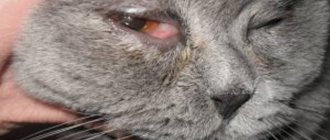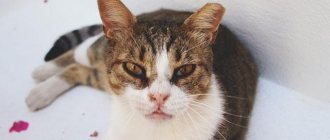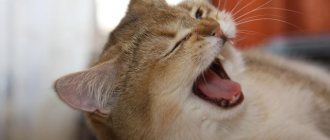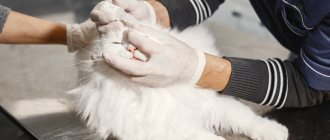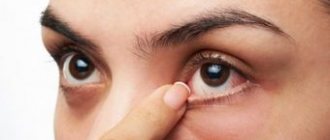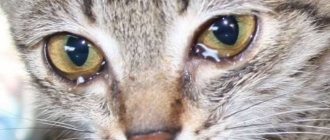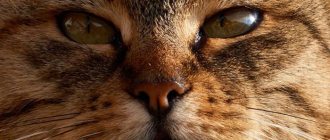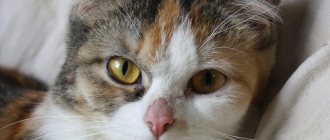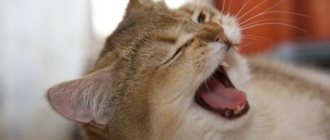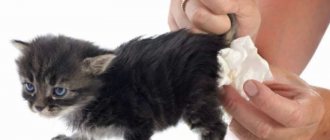Owners often notice that the Briton’s eyes are watery, while other pathological signs are recorded, and the general condition of the pet worsens. In such a case, you should not delay a visit to the veterinarian, as this may signal the development of serious ophthalmological diseases. But sometimes increased tearfulness is temporary and is associated with the impact of irritating substances on the British eyesight. In any case, you should not let the situation take its course and wait until the problem goes away on its own, since there are high risks of a decrease in the cat’s visual acuity and its complete loss if help is not provided in a timely manner.
Why do cats have watery eyes, main diseases.
In what situations do British eyes need to be treated:
- Inflammation as a result of injury, dust or insects getting into the eye;
- Conjunctivitis has developed;
- Prolapse of the third eyelid;
- Epiphora.
It is important to correctly determine the cause of eye inflammation; you should look at the discharge:
- Discharge yellowish, brown, thick, pus – infectious, bacterial or fungal disease;
- Watery, transparent, pet rubs | scratches eyes with paws - allergies, injury;
- Crusts, transparent, dried - dust or dirt has gotten into your eyes.
Conjunctivitis.
Infectious diseases, helminthic infestation, allergic reactions are the main causes of inflammation of the conjunctival sac.
Contagious diseases.
Lacrimation is a symptom of the following diseases: toxoplasmosis, chlamydia, calcivirosis, rhinotracheitis, panleukopenia. Both British breed cats and animals of other breeds are susceptible to this disease.
If left untreated, conjunctivitis becomes purulent, which will lead to the development of uveitis and may result in blindness.
Elimination of inflammation - treatment of the underlying disease.
Worm infestation.
Nematodes that live in the intestines produce waste products that have allergenic properties. As a result, the cat develops lacrimation and other pathological symptoms.
Elimination of conjunctivitis - deworming the cat with an anthelmintic; it is better to use 3 in 1 products - against fleas, ticks, and worms.
Allergic reaction.
The British, like other artificially bred breeds, are susceptible to allergies. The British breed also has a special skull structure.
Irritants that cause lacrimation:
- Cigarette smoke, dust, perfume, eau de toilette, air fresheners;
- Feed | food allergens. Poor quality feed causes hypersensitivity. Natural feeding often causes skin rashes and it is difficult to determine the source of the allergen.
Read more about foodborne dermatoses here.
Treatment - eliminate the inhaled irritant, find out the cause of the allergic response, use antimicrobial eye drops:
- “Diamond Eyes” - contains chlorhexidine;
- “Iris” contains gentamicin.
Prolapse of the third eyelid.
Blinking membrane disease | third century. Forms in which inflammation can occur: abnormal development of supporting cartilage, protrusion | prolapse, adenoma. If both eyes are affected, it is a contagious disease.
Antiphlogistic drops and ointments are used for unilateral inflammation. The effect is not achieved - they operate surgically.
Epiphora.
Epiphora is characterized by copious continuous discharge and very watery eyes. Britons experience blocked tear ducts or inflamed eyelids | blepharitis due to the special structure of the lacrimal canal.
Treatment - wash the eyes and place tetracycline ointment in the conjunctival sac for 5-7 days. The treatment did not help - they operated on him.
This is interesting: The cost of a British kitten
How to treat allergies
To achieve complete control over the disease and prevent relapses, allergic rhinitis (confirmed by diagnostic tests) is treated with 5:
- elimination measures - exclusion of interaction with allergens
- medicines of different pharmacological groups
- ASIT - allergen-specific immunotherapy (treatment is prescribed only during the absence of clinical manifestations)
To relieve symptoms use:
- Systemic and local antihistamines (tablets and drops). Medicines block the synthesis of the biogenic substance histamine, a mediator of an allergic reaction. They also reduce swelling of the mucous membrane and the amount of secretion released.
- Intranasal corticosteroids (hormones). They stop inflammation.
- Antileukotriene drugs. They prevent the development of obstructive complications (severe edema, bronchospasm, etc.) and reduce the need for hormonal therapy.
- Vasoconstrictor drugs. Use 5 minutes before injecting intranasal drugs (hormones) to relieve nasal congestion. Use for no more than 5 days.
Prevention measures
Cats are incredibly clean and can take care of their eyes on their own. They wash themselves regularly, putting themselves in order, but they are not able to cope with the disease. Owners of four-legged furry dogs should check them regularly. Particular attention is paid to animals that walk outside. To prevent pathology it is necessary:
- Feed your pet high-quality food. Balance your diet and don’t experiment with it.
- Visit the veterinarian, get vaccinations and examination of internal organs.
- Ensure your pet has an active lifestyle, play with him, and go out into the fresh air.
- Protect from contact with sick and unfamiliar animals.
- Regularly cleanse the body of helminths.
- Monitor the length of the claws and trim them in time so that the pet does not injure itself.
Owners of purebred cats prone to excessive tearing should make it a rule to treat their eyes daily. With increased tear production associated with the characteristics of the breed, you may not immediately notice that the animal has health problems. Monitor the nature of the discharge and pay attention to your pet’s behavior.
Simple prevention methods will help protect your cat from various troubles, including eye problems. If you have the slightest doubt about the causes of tearing, contact your veterinary clinic. Remember that home remedies are temporary measures to combat the problem. Only a doctor can rid an animal of the causes of unpleasant discharge.
This article will tell you what to do when a Scottish kitten has watery eyes. In addition, we will identify the reasons why the eyes become watery and tell you how to distinguish whether a kitten’s eyes are watery or festering.
Other Possible Problems
If more than two weeks have passed since birth, and one of the kitten’s eyes does not open, this should alert the owner. This phenomenon may be the cause of the development of a pathological deviation. It is best to show the animal to a doctor.
Important! If the cat's eyes do not open and are watering, this may indicate a foreign body. The appearance of pus indicates the development of conjunctivitis
Young kittens are very vulnerable to viral infections. Harmful bacteria can come from both the external environment and the womb. Therefore, owners of newborn kittens often experience inflammation of the organs of vision.
Eye is leaking
The reasons why a kitten's one eye is watery can be due to many factors:
- the appearance of infection is the most common phenomenon. The most common are chlamydia, herpes and mycoplasmosis, which are also contagious to humans. The presence of infection can only be determined through analysis of eye wash;
- allergic reactions may occur to food, dust and household chemicals;
- mechanical eye injuries that appear either after active play of kittens or due to burns. A speck of dirt can also get into the kitten’s eye, which will cause injury to the cornea, the eye will begin to hurt and leak;
- infection of an animal with parasites;
- disruption of the gastrointestinal tract;
- prolonged exposure to lighting devices, a bright light source.
Only a doctor can name the exact reason why a kitten’s eyes are watering. The conclusion is made after the diagnosis. As soon as an accurate diagnosis is made, the doctor prescribes how to treat the cat.
Tearing will be considered normal when it comes to Scottish and British breeds. It all depends on the structure of the skull. Due to the fact that these breeds have a flattened muzzle, their eyes are susceptible to the influence of the environment, and they constantly leak. Owners of these breeds should contact a veterinarian if they see changes in their pet's behavior.
Important! You need to monitor the color of the discharge from the eyes. If tearfulness with pus is observed, you should immediately contact a veterinarian
Pus from the eyes indicates the beginning of the inflammatory process.
A kitten's eye is leaking
If clear discharge without blood or pus is detected, you can get rid of it at home. To do this, you can wash your pet's eyes with tea and chamomile infusion. Products sold in pet stores have a good effect. You can purchase eye drops that will produce results within 2 weeks. If after treatment the cat continues to squint his eyes, they close and run, you need to show him to the veterinarian.
Squints his eyes
Pet owners should be wary if their pet squints one eye. This indicates that he is experiencing pain and discomfort. Most often this is accompanied by severe lacrimation and suppuration. In this situation, you urgently need to show the animal to a doctor and take the necessary measures for treatment. Squinting of the eyes can occur for a number of reasons:
the development of conjunctivitis is an inflammation of the mucous membrane, which is accompanied by swelling and purulent discharge. The diseased organ of vision becomes swollen, it begins to close and turn red. For treatment, special drops and rinsing are used. If the disease is detected late, antibiotic injections are prescribed; mechanical injury to the cornea, accompanied by severe pain. The complexity of such phenomena lies in the fact that microorganisms can enter small cracks in the corneal tissue and subsequently multiply.
Particular attention is paid to injuries caused by claws, under which a large number of bacteria accumulate, as well as worm eggs; Allergic reactions can be to household chemicals, dust, or to flowers and plants. If a kitten begins to squint its eyes in order to identify the causative agent of the allergy and prescribe treatment, the doctor conducts a diagnosis by taking tests; increased eye pressure
Most often, this phenomenon occurs in old animals due to age-related changes. If treatment is not taken, this condition can lead to blindness; Corneal erosion or damage to the membrane are the most common reasons why a cat squints. The impetus for infection comes from injuries, burns, and viral infections. If left untreated, the disease will lead to serious consequences such as corneal erosion.
Conjunctivitis
If your pet begins to constantly squint his eyes, you need to urgently take him for examination.
Additional symptoms
If the problem is not related to allergies, then the pet may have noticeable redness of the conjunctiva.
When a British cat's eyes become watery due to the influence of an allergen or irritant, no additional symptoms may be recorded. In this case, no special treatment is required and the problem goes away on its own after the irritant is eliminated. When pathological factors become the source of increased tearing, the Briton may develop a fever and experience other clinical signs:
- swelling in the area of the visual organs;
- purulent or mucous discharge;
- brown or red crust in the corner of the eye;
- itchy sensations;
- swelling of the conjunctival membrane and its redness;
- fear of bright light.
With prolonged tearing, Britons often experience hair loss around the eyes, which soon leads to sores and dermatitis.
Causes
Let's consider what could be the main reasons for the appearance of brownish or reddish discharge from the eyes of a pet.
Impaired outflow of tear fluid through the nasolacrimal duct (dacryocystitis)
- Narrowing and blockage of the lacrimal ducts due to the inflammatory process. Primary inflammation of the walls of the nasolacrimal canal leads to disruption of the outflow of tear fluid, as a result of which pathogenic microflora accumulates in it. The disease is accompanied by the release of mucus and pus from the corners of the eyes, the appearance of traces of blood in the discharge, and blurred vision. Treatment in most cases is conservative; if ineffective, surgical intervention is used.
- Stenosis (narrowing) of the lacrimal openings. Chronic conjunctivitis can lead to narrowing of the lacrimal openings - formations designed to drain waste tear fluid. The disease is characterized by standing tears in the eyes and constant lacrimation (epiphora). They begin to treat conservatively, with medication. If ineffective, bougienage is used - a procedure for probing the tubules with a special probe that dilates the ducts. With congenital stenosis, one cannot do without a full-fledged operation to widen the lacrimal canals (dissection of the lacrimal punctum).
- Blockage of the tear duct by a foreign object. Foreign bodies - midges, small debris - can get on the surface of the eyeball. They penetrate the tear duct with tears and clog it, causing symptoms of dacryocystitis. If the foreign body is not removed, inflammation may begin and, over time, the bacterial infection will spread to other ocular structures. The main symptoms are a local increase in temperature, redness, the appearance of yellowish and brown discharge, pain when blinking. The patency of the lacrimal canal is restored by rinsing and bougienage. After the duct is released, it is disinfected with liquid antiseptics.
- Injury to the lacrimal drainage apparatus. Injury to the lacrimal canaliculi usually occurs when the eyelids are injured. The discharge from the eyes of cats is dark or even black because blood particles get into the tear fluid. In order to restore the function of tear drainage, the torn edges are compared and sutured. If after scarring the passage through the tear ducts turns out to be difficult, then bougienage is performed.
- Benign and malignant neoplasms of the lacrimal glands. This is another reason for impaired tear flow. The main symptoms are impaired mobility of the eyeball, severe pain and increased intraocular pressure. If the disease is accompanied by tissue destruction, then blood may appear in the eye secretions, and they become reddish or brown in color. Treatment is only surgical. Chemotherapy may be used before or after surgery.
Infectious inflammation of various areas of the eye structures
- Conjunctivitis is an infectious inflammation of the conjunctiva (the mucous membrane of the eye). Infection occurs through household contact. The main symptoms are swollen eyelids, redness of the mucous membrane, purulent discharge. In severe cases, the discharge may be brown in color, as the choroid of the eyes is involved. Drug treatment is used. The mucous membrane is washed with antiseptic solutions, and antimicrobial ointments are applied. If there is no effect, injections are made into the conjunctiva.
- Blepharitis is inflammation of the ciliary edge of the eyelids. The cause of the disease is infection of the hair follicles of the eyelashes. It can be provoked by low immunity, infectious ophthalmological and general diseases. The main symptoms are inflamed eyelids, accumulation of grayish secretion in the corners of the eyes. With ulcerative blepharitis, the inner surface of the eyelids ulcerate, becomes red, and the discharge acquires a brownish tint. Treatment includes therapy for the primary infection and increasing the body's resistance. Antibacterial treatment of eyelids is performed. For ulcerative forms of blepharitis, it is possible to use hormonal ointments.
- Keratitis is an infectious lesion of the cornea. The cause is often traumatic damage to the surface of the eye, since bacterial microflora is always present on it. A complication of keratitis can be a purulent corneal ulcer. Keratitis can be caused by pathogens such as tuberculosis, brucellosis, salmonellosis, and chlamydia. The disease is accompanied by the formation of an infiltrate, which, with deep ulcerations, can acquire a brownish tint. Treatment is medicinal and complex. The treatment regimen depends on the etiology of the disease. Antiviral, antifungal, antibacterial, antituberculosis, antihistamine and other drugs are used.
- Iridocyclitis is an inflammation of the iris and ciliary body. The disease is also called anterior uveitis because it is an inflammation of the uvea of the eye. It can be caused by pathogens of viral, bacterial, fungal infections. Pathology is provoked by chronic infections of the upper respiratory tract. The main symptoms are redness of the mucous membrane, pain, photophobia. The iris may change color. With prolonged inflammation, the anterior chamber is filled with purulent exudate, and if the vessels are damaged, with blood (hyphema). Vision may be seriously affected. Treatment is aimed at eliminating the cause of the disease. Antiviral, antifungal, antibacterial, and detoxification therapy are used.
Grown-up individuals
After 6 months of age, any discharge from the animal’s eyes should stop. If the problem does not disappear, it is worth monitoring the pet’s behavior. If a Briton’s eyes are watery for several days, the cat scratches them and squints, we can assume different versions:
- hit by a speck;
- blockage of the tear ducts (the eyes begin to sour);
- mucosal injury;
- allergies to various pathogens;
- helminthic infestations;
- infections – dangerous and not so dangerous.
Before proceeding with treatment of the pathology, the cause of lacrimation should be established.
Pathogenesis
Tears from a cat's eyes are the body's protective response to irritating factors, both internal and external. It is considered one of the normal variants when a small amount of discharge accumulates and dries in the inner corners of the pet’s eyes - this becomes especially noticeable when the animal wakes up after a long sleep. The natural mechanism necessary for wetting and washing the eye organ in cats is not dangerous, so clear tears are considered normal. If a cat produces tears in large quantities, or if they contain traces of pus or blood, this may indicate the development of a serious pathology.
Generally speaking, the most common reasons why a cat may have watery eyes are: mechanical damage to the organ of vision, the introduction of viruses, microbes, and allergies. The severity of certain symptoms, as well as the choice of treatment tactics, largely depends on the cause.
[14], [15], [16], [17], [18], [19], [20], [21], [22], [23]
Source
The veterinarian invites you to read the article: “The cat’s eyes are watery: causes, treatment and prevention.”
Symptoms
If a pathological cause is obvious, all manifestations of the disease should be observed to give the doctor as complete a history as possible to ensure the best decision.
Common cat diseases manifest themselves as follows:
| Symptom | Disease and cause |
| Long and profuse tearing. | Viruses and fungi such as plasmosis: calcivirosis, mycoplasmosis, toxoplasmosis, etc. |
| Pus. | Foreign objects. |
| Edema. | Turn of the century. |
| Cloudiness. | Keratitis, cataract. |
| Black spot. | Dying of the cornea. |
| Tears are accompanied by fever, diarrhea, vomiting, and lethargy. | Feline distemper (panleukopenia). |
| Swelling with cloudiness. | Glaucoma. |
| Swelling in the corners of the eye. | Inflammation of the lacrimal glands. |
| Redness of the membranes, photophobia. | Conjunctivitis. |
| Damage to one eye. | Parasites. |
This is interesting: When to castrate a British cat
We are ready to help
Our clinic specialists treat nosebleeds and other diseases in your pets. If your cat is unwell, please contact us. We apply the latest technologies, use high-quality equipment, and guarantee high professionalism and attentive attitude towards four-legged patients. You can call our specialist at home or come to the clinic.
The article provides an opportunity to understand why such a problem may occur and answers questions about how best to deal with it and what to look for in solving the most common difficulties with bleeding in kittens
The kitten has a nosebleed and is sneezing: causes and treatment
If your kitten is bleeding when he sneezes, you might want to consider whether he may have inhaled some chemical that could be causing the symptoms. The kitten must be taken to a doctor immediately, but if this is not possible, then you should try to stop the bleeding and sneezing at home.
This can be done in the following ways: apply ice compresses to the kitten or give the pet a vasoconstrictor.
The kitten has bleeding from the nose and mouth, eyes, what should I do?
The kitten may bleed from the eyes, nose and mouth, perhaps in cases where it has fallen from some height, or it has eaten some kind of poison. In any case, a doctor’s examination is necessary, and the sooner the better, since nothing can be done to help the kitten at home.
How to stop a cat's nose bleeding
If a cat has bleeding from its nose, then, firstly, there is no need to panic, since nervous excitement is transmitted to cats, which in their case is extremely harmful, as it leads to an increase in blood pressure.
Secondly, you need to apply a cold compress to the back of your cat's nose, making sure that your pet does not block his breathing.
If the bleeding has not stopped and the cat has breathing problems, the animal urgently needs to be shown to a veterinarian. If everything is fine with breathing and the blood has stopped, there is no need to panic.
When the blood stops flowing, you should take a napkin and water and clean the animal’s nose.
Any bleeding in a pet causes strong emotions in owners: from anxiety to panic. Nothing human is alien to cats, and therefore they are susceptible to nosebleeds no less than people. Sometimes this is a single manifestation of some temporary disorder, sometimes it is a signal of a serious illness.
Let's figure out why a cat's nose bleeds when sneezing, and how you can help it.
What to do and how to deal with the problem?
“Diamond Eyes” drops will put the animal’s visual apparatus in order.
If your Briton's eyes start to water, you can help your pet at home. Antiparasitic drugs are purchased from a veterinary pharmacy and given to the animal. In this case, it is recommended to prepare a chamomile-based decoction or strongly brew black tea and wipe the Briton’s sore eyes several times a day so that they stop watering. The procedure is performed with clean hands, using a separate cotton pad for each visual organ. If home methods do not help eliminate excessive tearing in cats of the British breed, then contact a veterinarian who will conduct an examination and prescribe drug therapy. The following veterinary drugs help with violations:
- "Iris";
- "Diamond Eyes";
- herbal lotion “Fitoelite”.
You should not give pets medications at your own discretion, since many of them have contraindications and can lead to complications. To combat increased tearfulness, tetracycline ointment is used, which is placed under the eyelid. Furacilin solution and potassium permanganate diluted in water are also useful. British people wash their eyes with these products several times a day. To prevent watery eyes in British cats, you should monitor their diet and avoid allergic reactions and parasites.
Pathology or not
If a cat’s eyes are running, this phenomenon may be normal or indicate a pathological process.
In case of various diseases in a pet, the discharge is characterized by an unusual color (yellow, transparent, red, brown, green). In pathology, tears flow heavily, the eyes are slightly swollen, and the animal constantly rubs them. Sometimes the cat cannot open them completely.
Discharge rate
In cats of this breed, discharge is considered normal if:
- they are transparent;
- not very abundant;
- occur after sleep.
In this case, there is no need to treat the animal. This is a normal process in British breed cats.
Eye diseases typical for the breed
It is not uncommon for a British cat to have watery eyes due to a common cold caused by sitting in a draft. The presented breed has a “weak spot” and these are the eyes, so sometimes the problem can make itself felt even when, it would seem, there are no provoking factors.
Conjunctivitis
If a Brit's eyes are watery, conjunctivitis may be suspected. The trouble occurs due to inflammation of the eye membrane, which is caused by various pathogens. For the disease to make itself known, it is enough for the animal to rub its muzzle on dirty shoes, for example.
Worm infestation
Experienced breeders know that the parasites that live in the intestines of pets, or rather the waste products of worms (nematodes), lead to the development of allergies, which are manifested by tearing, sneezing, and sometimes hair loss. Therefore, if cats have not been given anthelmintics for a long time, then it will not be a bad idea to do so. The tearing of the eyes of a British kitten caused by this problem will stop the very next day.
Contagious diseases
Sometimes the eyes become watery because the animal is seriously ill.
This could be one of the following diseases:
- rhinotracheitis;
- toxoplasmosis;
- panekleukopenia;
- toxoplasmosis;
- calcivirosis.
Often, a serious illness is manifested not only by the appearance of tears, but also by other striking symptoms that cannot be ignored. In this case, it is necessary to begin to eliminate the underlying disease.
Important! If treatment within 1-2 days does not have an effect, you should immediately seek help from a veterinarian!
Epiphora
It's one thing when British kittens have watery eyes, but it's quite another when the animal literally washes itself with tears. In this case, we can assume that the pet was struck by epiphora. This disease is not uncommon in the British population, due to the structure of their tear ducts. During inflammation of the eyelids or blockage of the canal, spontaneous release of fluid occurs.
Third eyelid prolapse
One common eye condition in the UK is nictitating membrane or third eyelid. In this case, inflammation develops, occurring in several stages.
Namely:
- adenoma;
- dropping out;
- abnormalities in the development of supporting cartilage.
In this case, the British eyes water, but only at the initial stage. Then pus may begin to ooze. If you do not begin to eliminate the disease in time, it may lead to surgical intervention .
How to cure a British kitten whose eyes are watery?
If you suddenly find that your little British kitten's eyes are watery, then you shouldn't be too upset. This is a fairly common problem. It is necessary to understand this problem. So, we note the most basic reasons why a British kitten’s eyes become watery:
Anthelmintics are the first treatment vets use when they notice tearing in Britons. You may also be advised to get tested, but you should never refuse, because not all problems are visible outwardly even to qualified specialists.
This feature is due to the breed of British cats. The flattening of a kitten's muzzle can provoke a narrowing of the tear ducts (if you understand medical terms, this is due to the special structure of the cranial-maxillary bones). The absence of fever and a normal appetite in the kitten will allow you to be calm.
Often allergic reactions are associated with inappropriate feed composition.
It is indeed a proven fact that cats can have watery eyes in rooms with fluorescent lamps.
The protruding membrane on the eyes of British cats can cause allergic reactions to dust, so do not be lazy to do wet cleaning to keep your kitten healthy. And this will also benefit your household, because people are increasingly becoming allergic to house dust.
If you choose the wrong food for your kitten, then in addition to indigestion and stomach problems, you can lead to an inflammatory process in its intestines. Be careful and careful, because this is fraught with consequences.
Having ruled out all of the above causes of tearing, still try to give the kitten anthelmintic drugs and then use these little instructions.
General recommendations
We test all the products on ourselves before we give them to the kitten. Yes, that’s right, if you don’t have any abnormal reactions, then this remedy will be suitable for a kitten. Also, be sure to thoroughly understand the problem, is it really tearing or is it rotting eyes?
If you have determined for sure that this is a simple discharge of tears from the eyes, which is typical for little Britons, then try to carry out comprehensive first aid for your little “fluffy”.
Simple remedies
- If the tears are not very profuse, then try rinsing with just water or tea.
- Brew your kitten a decoction of chamomile, sage, St. John's wort or calendula herbs. Moreover, the following features must be taken into account:
- sage is used to eliminate dryness that can occur in the morning in the British;
- chamomile fights well against conjunctivitis, primary suppurations (i.e. not advanced);
- calendula will be useful if the kitten has an allergic reaction to something;
- The microbial and viral environment is best killed by decoctions of St. John's wort; the remedy is quite effective and accessible to everyone.
Treatment with herbal decoctions should be carried out as follows: wash your hands thoroughly, take a clean cotton swab and start wiping the eyes from the outer corner to the inner, then take a new swab and repeat the procedure until the problem is completely eliminated.
Treatment with veterinary drugs
- Use a solution of potassium permanganate, furatsilin (1:10), albucid or sodium sulfacyl. Side effect: The fur around the eyes may darken from the medications.
- If you apply tetracycline ointment at night, the improvements will be clearly visible. Place tampons with ointment behind your eyelids. This way you will get rid of the infection.
- On the shelves of veterinary pharmacies you can also find products such as “Iris” and drops based on chloramphenicol.
- Your kitten can also benefit from Diamond Eyes drops. The basis of this drug helps to help with your problem in the shortest possible time.
- Hygienic lotions such as “Phytoelite” can replace herbal decoctions; their principle of action is similar, you just don’t need to spend time preparing them.
More in Nursing
At what age should a British cat be neutered?
Without a cat, life is bad. We have all heard such a saying, and we cannot imagine our life without these fluffy, so affectionate and devoted animals. But time passes...Read more →
What is the best food to feed a British cat?
One of the representatives of aristocratic cat breeds is the British Shorthair cat. This is a strong, independent, intelligent, calm and beautiful animal. It is these properties that make the British breed ideal...Read more →
What time do British cats shed?
Cats are perhaps the most beloved of pets. Any changes in a pet’s body, including molting, not only cause fear among owners, but sometimes...Read more →
There is 1 comment in this section
My kitten’s eyes also often water, constantly, and the doctor said that there was no reason, Visomitin prescribed such sensitive to dust and drops. I have to drip, otherwise I cry all the time
Source
When your Briton's eyes water and other accompanying symptoms appear, you need to take your pet to the vet and find the root cause of the problem. Often the provocateur can be helminths or an allergy to a food product.
Are watery eyes a breed trait?
You can often hear the following phrase from veterinarians and pseudo-experts regarding lacrimation in the British: “What do you want? This is such a breed, their eyes are always streaming.” There is some truth in this, but only partly. Let's figure out why British cats actually have watery eyes.
Representatives of the British breed are brachycephalic, i.e. cats with a spherical head shape, including due to the fact that they have a shortened muzzle. Compare the skull of a brachycephalic and a non-brachycephalic.
The spherical head is a breed standard, giving it a special charm, but with it the British received an atypical anatomical structure of the nasolacrimal ducts. Brachycephalic cats and dogs have some curvature and deformation of the nasolacrimal ducts, which, when severe, makes it difficult for tears to flow into the nasopharynx.
Despite this, normally a British cat should not have constant lacrimation. Most representatives of the breed have healthy eyes, because breeding cats and female cats are selected not only for beauty, but also for health. We are, of course, talking about animals from officially operating nurseries according to all the rules. You can expect anything from the British, bought second-hand.
If there is a problem with lacrimation, this means that:
- the breeder did a poor job and was unable to maintain in his graduates the structure of the nasolacrimal duct that allows normal functioning;
- or the cause of lacrimation is not anatomical features at all.
Also, it often seems to the owner that the condition of the eyes is unhealthy, but, in fact, everything is in order. Below we will teach you how to distinguish normal from pathology.
Why does a cat sneeze in normal situations?
Common reasons are:
- Allergens . Cats, particularly purebred cats, are very gentle creatures and react sensitively to many factors. This may include dust accumulation, cleaning chemicals, air fresheners, perfumes and deodorants, essential oils, indoor plants and outdoor pollen during the flowering season. Since cats have an excellent sense of smell, strong food odors (spices, onions and garlic, alcohol, citrus fruits) can also trigger sneezing. Or maybe you recently changed your pet’s diet or purchased a new litter box? You need to take everything into account and track what exactly causes sneezing, and then eliminate these causes.
- Hypothermia . Sometimes sneezing occurs if your tailed pet has access to the street and it is snowing or raining. Open windows during the cold season, air conditioning or a fan can also create favorable conditions for the development of pathogens, especially if the cat has a weakened immune system. Because of this, fever and runny nose are often also noted. Therefore, after getting wet outside or after swimming, you should dry your pet thoroughly and do not allow it to lie on cold floors or drafts.
- Foreign bodies . Cats are very curious, they explore everything with their nose, so they can inhale small objects: particles of plants, insects, water, grains of food. This causes involuntary sneezing to remove the irritant from the mucous membrane. If you suspect that something has gotten into your pet's nose, you can examine his nostrils with a flashlight. If you cannot see anything, it is better to visit a doctor to make an accurate diagnosis and provide appropriate assistance.
- Anatomical features . Some purebred cats have short noses. This structural feature of their muzzle can cause a runny nose and constant nasal congestion.
Normal and pathological - how to distinguish?
Many owners notice brown crusts in the corners of their cats' eyes after sleeping. This is the norm. When released, the tear is transparent and does not have any impurities. The liquid then lingers on the fur and oxidizes in the air, resulting in the feeling that your British cat's eyes are watering brown. In fact, brown crusts (sometimes they have a reddish tint) are just dried, oxidized tears. It looks like this.
Pathology is observed when:
- tears flow constantly, even while awake, there are a lot of tears, as if a cat is crying (scientifically the phenomenon is called epiphora);
- the tear is cloudy, whitish, greenish or yellowish;
- in addition to the tears, it is clear that the eyelids and conjunctiva are inflamed;
- hair falls out around the eye;
- blepharospasm (the cat squints its eye).
Manifestations of pathology
Before treatment, the animal’s condition should be assessed, so pay attention to the duration and nature of eye discharge, the presence or absence of other symptoms. Signs may be as follows:
Signs may be as follows:
- profuse lacrimation;
- swelling around the eyes;
- brown, green and yellow discharge;
- impurities of pus in the discharge.
A Scot with pathology may constantly rub his eyes.
In some cases, symptoms include:
- hyperthermia;
- copious nasal discharge;
- drowsiness;
- changes in habitual behavior;
- apathy;
- pet anxiety;
- cough.
If symptoms appear that are not normal, you should consult your veterinarian.
Rules for washing and instilling eye drops
If one of the points of treatment for a cat is eye drops, then it is important to know how to carry it out while causing minimal discomfort to the pet.
For this you need:
- sterile pipette or syringe;
- product (drops, ointment) at room temperature;
- clean wipes or tampons;
- food to encourage and relieve stress in cats.
It is advisable to carry out the burial with an assistant who will help hold the frightened animal. The cat must be well secured. In extreme cases, it is tied with soft cloth.
With a moistened swab, wipe the pet's eye from the outer corner to the inner, removing crusts and drops of secreted liquid. Then the eye is wiped again with a clean napkin.
Now you can start instilling: open the cat’s eyes wide with the thumb and forefinger, after which the product is quickly instilled directly under the eyelid. Excess liquid is blotted with a napkin, then the cat is rewarded for its bravery and released.
Pregnant and small pets require a special approach. Cats expecting the birth of babies are rarely prescribed medications; rinsing is done with chamomile or calendula decoctions, a tea solution, and in extreme cases, tetracycline ointment is applied. Newborn kittens with high tear production are prescribed Bars or Anandin drops.
Heartworm infection in a cat
It is extremely rare, but still occurs in practice, that such cute creatures as cats become infected with heartworms when they find themselves in places with very high air humidity and a maximum number of mosquitoes. Why these insects? Yes, because it is through their bite that the parasite is transmitted to the pet. The heartworms themselves, once in the cat’s body, affect the right side of the heart, as well as the lungs. As a result, the arteries become clogged, it becomes difficult to breathe, and coughing and sneezing begins. And the end is often sad - a heart attack and death.
To protect your mustachioed pet from these parasites, follow the following preventive measures:
- maintain strong immunity,
- ensure proper diet and lifestyle.
And when traveling outdoors, you can prepare a special mosquito repellent in advance (dilute citronella with plain water). This composition will reduce the risk of parasite infection to a minimum, which will undoubtedly preserve the health and, of course, the life of your pet. This is just the simplest measure to prevent infection with malicious worms. Your veterinarian will cover this topic in more detail.
Treatment of eyes at home, what to wipe with, what to do?
Your pet can treat the affected areas at home, either with special veterinary products or with medications from a pharmacy.
Step-by-step processing instructions | rubbing the eyes of a kitten, cat:
- Wash your hands well with soap and call an assistant;
- Prepare a 5 ml syringe with a rubber piston, cotton pads;
- Prepare distilled water | boiled, necessary drops or ointments;
- Particularly violent ones should be wrapped in a blanket or towel and placed with their backs on their knees;
- Soak the disk with water and solution. Wet your eyelids if they are stuck together;
- Gently move the wet disc from the outer edge to the inner corner along the surface of the eyelids; if the eyelashes are stuck together, move from the inner to the outer;
- Dry crusts are removed and the cotton pad is changed more often;
- After rinsing, drop the solution onto the cornea or apply ointment, massage the eyelid a little and blot off the excess with a cotton pad.
Any solution is at room temperature. Use clean cotton pads for each eye. Do not touch the cornea, blot the eyeball.
Eye washes
Pharmacy products.
The following medications can be purchased at the pharmacy:
- Decoction of herbs, tea: chamomile, hyssop, calendula, St. John's wort. 1 – 2 teaspoons of herb are poured with 0.5 glass of boiled water, left for 10 – 15 minutes, filtered, cooled, and wiped the animal’s eyes. In light-colored cats, the fur around the eyes may become stained. Only freshly prepared infusions are used;
- Chlorhexidine solution 0.01%;
- Saline solution 0.9% - sodium chloride solution 0.9%. A higher percentage will lead to burns of the mucous membrane;
- Furacilin solution 0.02%;
- Antibiotic drops chloramphenicol, ciprofloxacin, tobrex - for purulent conjunctivitis, prescribed by a doctor.
Veterinary products.
Veterinary pharmacies, clinics, and pet stores offer the following products:
- Tetracycline eye ointment 1% - antibiotic;
- Oftavetin cipro is an anti-inflammatory, antibacterial drug;
- Oftavetin dexa - antiallergic, anti-inflammatory effect;
- Optimmune - ointment, active ingredient - cyclosporine A;
- Anandin – treatment of infectious diseases, rhinitis;
- Maxidin is a drug for the treatment of allergic and infectious diseases of the eyes and upper respiratory tract;
- Iris – treatment of eye diseases;
- Diamond eyes - drops for daily hygienic treatment;
- Oftalmosan - the drug has anti-inflammatory, antiseptic, detergent properties, relieves swelling of the eyelids, reduces itching;
- Tsiprovet - prescribed for blepharitis, keratitis, corneal ulcers, septic iridocyclitis, conjunctivitis, keratoconjunctivitis;
- Bars - drops belong to combined antibacterial drugs with a wide spectrum of action;
- Doctor VIC lotion is a zoohygienic product designed to cleanse the areas around the eyes;
- Rosinka lotion is a hygiene product;
- Teardrop – hygienic lotion with royal jelly.
Every cat or dog owner may encounter eye problems with their pet. To minimize the problem, you need to feed your pet properly and provide the necessary timely care. Knowing how to treat a cat's eyes is as important a skill as being able to trim its claws. Save the article to bookmarks and share with friends.
What measures should be taken?
Nosebleeds in a cat are a serious symptom that requires immediate attention. What to do if a cat has a nosebleed and what does this indicate?
Causes of the disease
A cat's nose consists of two parts: bone and soft (shell). The mucous membrane, containing nerve endings and blood vessels, lines the nasal cavity. In case of inflammation of the nasal mucosa or mechanical damage to its vessels, profuse bleeding from the nose occurs. Sometimes a cat sneezes blood.
However, a pet's nosebleed may be the main consequence of:
- injuries (fall, impact);
- chronic hypertension (constant high blood pressure);
- entry of a foreign object into the upper respiratory tract;
- infectious disease;
- use of medications (for example, Warfarin);
- oncological pathologies;
- poisoning;
- hemophilia (chronic bleeding that develops against the background of decreased blood clotting);
- fungal infections;
- purulent inflammation;
- dental problems.
First aid
- It is necessary to calm the animal. Otherwise, an excited state can increase blood pressure, which will contribute to increased bleeding. Never give your pet sedatives. This can only harm the situation.
- Calm down yourself.
Remember: the cat detects the nervous state of its owner.
- You can reduce bleeding by applying an ice pack to the bridge of your nose.
- If there is no positive dynamics and if there is difficulty breathing, urgently call a veterinarian at home or go to the clinic yourself.
If you notice swelling on the body, deformation or asymmetry of the muzzle, the appearance of the third eyelid, its redness, swelling of the back of the nose - this should be reported first.
Important: these pets are accepted without a queue! Black, soiled stool indicates intestinal bleeding. Vomiting blood - about stomach
However, vomiting after bleeding may be a consequence rather than a cause, since the cat simply swallows a large amount of blood. If the mucous membranes of the oral cavity become marbled in color, immediately tell your doctor. This is a clear sign of severe bleeding; the pet needs urgent hospitalization and qualified care. The veterinarian should be notified of any medications the cat may have taken.
Diagnostics
If your cat has persistent nosebleeds, you should immediately consult a doctor. Otherwise, irreversible processes may begin in the animal’s body. The veterinarian prescribes the following examinations:
- General analysis of blood and urine (assessing the extent of blood loss by counting platelets, identifying the source of inflammation, identifying problems in the kidneys).
- Biochemical blood test (determining the rate of clotting, assessing the functioning of internal organs).
- Serological test (detection of diseases caused by fungal infection).
- Rhinoscopy (detection of a foreign body, its removal).
- X-ray of the chest, nose (excluding pulmonary hemorrhage, assessing the condition of the nasal sinuses, tooth roots).
- Pressure measurement.
- Surgical method (used in exceptional cases when other tests have not helped to identify the cause of nosebleeds, necessary to remove a foreign body in hard-to-reach places or take a tissue biopsy).
Once the diagnosis is made, the veterinarian prescribes treatment, the purpose of which is to eliminate the original cause of the bleeding. As a rule, it is medicinal. If cancer is detected, a surgical method (tumor removal) can be used.
Why do cats cough? What could this symptom indicate? — read the article What to do if your cat coughs?
Treatment options
Before starting treatment for tearfulness, you should carefully study the nature of the discharge and the condition of the animal. Contacting a veterinarian is mandatory and immediate if not only the eyes are running, but also the following symptoms and conditions are observed:
- increased body temperature;
- refusal to eat and drink;
- the appearance of pus in the nasolacrimal duct.
When your pet's health condition does not cause concern, you can resort to simple but effective treatment methods at home. Among them:
- Regularly rubbing your eyes. Herbal decoctions and tea leaves are suitable for this purpose. You can purchase a special herbal-based lotion Phytoelite. To eliminate possible infection and disinfect mucous membranes, dissolve potassium permanganate in water until a pale pink tint appears and wipe the eyelids, moving towards the bridge of the nose.
- Applications of tetracycline ointment are recommended to treat purulent eyes in the UK. The drug has a wide spectrum of action and inhibits the activity of microbes. To achieve a lasting therapeutic effect, the ointment is applied to the eyelids in a thin layer in the evening and left until the morning.
- A remedy called Iris will help eliminate irritation and allergic reactions. The composition contains chloramphenicol, which can quickly restore eye health.
- Diamond Eyes drops containing succinic acid and taurine have a good therapeutic effect. Suitable for combating the disease and preventing it.
It is recommended to treat watery eyes in British cats with medications only after consultation with a specialist.
An incorrectly selected remedy can aggravate the condition and lead to the development of chronic inflammatory processes. You can do the washing yourself, if necessary.
How to treat a cold
In the treatment of viral or acute catarrhal rhinitis caused by hypothermia, topical preparations (drops and sprays) are used 4:
- Antibacterial and antiviral. They destroy pathogenic microflora and prevent the spread of infection into the auditory and lower respiratory tract.
- Mucolytics. They reduce swelling of the mucous membrane, thin out accumulated mucus and help clear the nose.
- Vasoconstrictors (decongestants). Relieves nasal congestion and eliminates swelling of the mucous membrane. One such drug is Xilong nasal spray. It contains the vasoconstrictor substance xylometazoline and dexpanthenol, which has a regenerating effect. For children from 2 to 6 years old, Xilong Kids spray is provided.
To enhance the therapeutic effect, before using sprays, the nasal passages are washed with aqueous solutions of sea salt.
Prevention of lacrimation
Whatever condition your British cat’s eyes are in now, you need to remember preventive measures.
- Take care of the animal's immunity, because... Often the cause of problems is latent infections and the riot of opportunistic microflora. Maintaining immunity consists primarily of healthy eating, physical activity and a lack of stress.
- Avoid contact between the animal and sick brothers. Many people like to pick up stray cats on the street and immediately bring them home. It is not right. The animal must be examined by a veterinarian followed by quarantine.
- Brush your cat regularly to keep dead hair out of your eyes. If you have already gotten it, you need to rinse your eyes.
- Do not use antibacterial eye drops unnecessarily. The organ can be constantly washed only with saline solution.
- Regularly give your cat raw meat, eating which provokes the secretion of tear fluid and clearing of the nasolacrimal ducts.
- Perform regular routine deworming and, if necessary, preventative or therapeutic treatment against fleas and ticks.
- Try not to use aroma lamps and sticks, aerosol air fresheners at home, and do not smoke.
- If a problem occurs, contact your veterinarian immediately. Do not engage in self-treatment, which blurs the symptoms and leads to relapses, and also makes it difficult for the veterinarian to make a diagnosis.
MORE ON THE TOPIC
Kitten care
Caring for Scottish Fold kittens is easy. The coat does not require special care; it is enough to comb it once a week; it is enough to wash the eyes once every 5-7 days.
The only thing worth paying attention to is ear care. This issue should be treated very carefully. It is the ears that are the calling card of this cat breed, but at the same time they are also a weak point.
It is the ears that are the calling card of this cat breed, but at the same time they are also a weak point.
Eye examination and cleaning
If your eyes are healthy, then there is no special need for rinsing, you just need to keep them clean. But if the eyes are inflamed, they should be washed 2-3 times a day; this can be done with plain water, a weak chamomile solution or a medicated solution. To do this, you should use a cotton swab or soft cloth. If the inflammation lasts more than a week, then you need to consult a specialist.
Ear cleaning
This procedure should be done two to three (more often) times a month. To clean, use a cotton swab slightly moistened with a special liquid. The procedure must be carried out carefully so as not to damage the auricle.
This is interesting! It is better not to use cotton swabs, but regular cotton swabs will do just fine. You should not twist or pull the ears, as this can cause pain to the kitten and he will be afraid of this procedure. If the ears are healthy, there is no discharge, but there may be a small amount of earwax.
The presence of a thin brown crust in the ears is an alarming sign; it indicates the presence of ear mites. In this case, you cannot do without a visit to the veterinarian. The treatment will be long with the help of a special solution. If measures are taken in time, the prognosis is favorable.
Grooming
To keep your Scottish Fold kitten beautiful and well-groomed, you need to take care of its fur; it’s not at all difficult. To properly care for the coat, you should use a special brush or silicone glove. During the shedding period, it is recommended to comb it once a week, the rest of the time once every two weeks will be enough.
While at the dacha, you should pay special attention to this procedure, carefully examine the animal every day for ticks and other parasites.
Bathing, washing
Scottish fold kittens must be accustomed to water procedures from childhood. To do this, you need to gradually moisten them with a damp towel, and then give your pet a treat so that he develops a reflex that a bath is not scary. In the future, you can safely wash the kitten. Particularly active kittens are recommended to be protected in a special way before taking a bath. To do this, cover your ears with tampons. or you can simply cover them with your hands to prevent water from entering. Your eyes also need protection; you can even drip special protective oil into them, but this is not necessary.
Important! The water should be warm, approximately 36 degrees. Water that is too cold will cause hypothermia and your Scottish Fold kitten will get sick. Hot water is also harmful; due to the increased temperature, the animal’s heart rate will increase and breathing will become more difficult.
Eventually, your pet will not tolerate the uncomfortable conditions and will escape from the bathroom.
Hot water is also harmful; due to the increased temperature, the animal’s heart rate will increase and breathing will become more difficult. Eventually, your pet will not tolerate the uncomfortable conditions and will escape from the bathroom.
When washing your Scottish Fold kitten, be sure to use cat shampoo, and then its coat will be healthy and shiny. The products are not suitable for humans, they will cause skin irritation and worsen the condition of the coat; in severe cases, dermatitis is possible.
Nail trimming
Very sharp, thin claws of a kitten should be trimmed with special clippers for small animals.
The advantage of such a tool is that they give a straight cut without splitting the claw - this is very important! When caring for a kitten's claws, only the very tip is removed. Under no circumstances should you damage a blood vessel; this will cause severe pain and can lead to the most negative consequences. In this case, a simple rule works: it is better to cut off too little than too much.
In this case, a simple rule applies: it is better to cut off too little than too much.
Conjunctivitis and other eye diseases
Tears in a cat can be caused by eye diseases:
- conjunctivitis - the veterinarian prescribes laboratory tests to determine whether the disease is caused by a virus or bacteria, and prescribes treatment with antiviral or antibacterial drugs;
- cataracts – clouding of the lens occurs after injuries; in animals suffering from diabetes mellitus and other chronic diseases, identifying the disease in the early stages allows to slow down its progression;
- glaucoma - develops against the background of increased intracranial pressure; due to a violation of the outflow of intraocular fluid, the animal experiences severe discomfort; surgical and drug treatment will alleviate their condition and preserve vision.
Tests for nosebleeds
After collecting anamnesis and narrowing the range of diagnoses, the doctor should double-check his assumptions by conducting tests:
- General blood analysis. Indicators that help in diagnosis are the level of red blood cells and platelets. A lack of blood cells indicates anemia or a bleeding disorder, respectively.
- Blood chemistry. Typically, blood is taken for key indicators, which are “distorted” in the event of malfunction of specific organs. For example, bilirubin can be considered a marker of liver function.
- General urine analysis.
- Blood clotting tests are a series of tests that evaluate the function of platelets.
- X-ray – performed to confirm or remove diagnoses: injury, neoplasm, dental disease, etc.
- Check your blood pressure – High blood pressure can cause nosebleeds.
- A nasal swab or wash is a series of tests that helps identify fungal and bacterial infections.
If the doctor cannot narrow the diagnostic spectrum based on symptoms, the diagnosis will be carried out according to the “simple” principle. That is, first they rule out trauma to the head and spine, for this they do an MRI. If the examination is not indicative, an examination of the nose and upper respiratory tract using an endoscope is prescribed.
